
In this issue
This issue of the ILC 2019 Daily News covers the past, present and future, with highlights from the last 4 years of JHEP, a host of real-world data for current treatments and the late breaker session heralding potential new hopes for the treatment of NASH, primary biliary cholangitis, and chronic hepatitis B virus infection.
In the second of this week’s award ceremonies, two young EASL Fellows, Dr Virginia Hérnandez-Gea (Spain) and Martin Guilliams (Belgium), received the EASL Young Investigator Award in recognition of their outstanding international liver research achievements to date. Further funding and studentships awarded to help young researchers in the development of their careers included:
- EASL Juan Rodes PhD Studentships
- EASL Sheila Sherlock Postgraduate Fellowships
- EASL Daniel Alagille Award, which promotes biomedical research in paediatric and adult cholestatic diseases
Also in today’s edition – catch up on the top picks with ILC Insights from the late breakers and parallel sessions and a message from the new Secretary General of EASL.

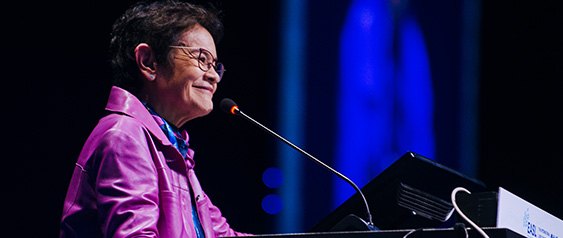
New treatments and new approaches – the latest results
Encouraging results were reported from interim analyses of two Phase 2a studies assessing hepatitis B core protein allosteric modulator ABI-H0731 in chronic HBV infection. In treatment-naïve patients, 731 therapy led to faster, deeper declines in HBV DNA vs. a nucleos(t)ide (NUC) inhibitor and adding 731 to NUC therapy led to superior antiviral activity versus NUC monotherapy. A favourable safety profile was observed in both studies. In an observational study in 29,350 patients, tenofovir was associated with a lower risk of HBV-related HCC than entecavir over more than 5 years of follow up.
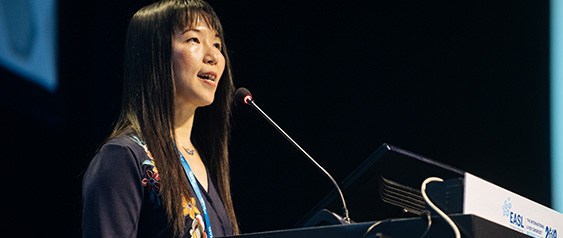
In the ENCORE-PH Phase 2b trial in patients with NASH-related compensated cirrhosis with severe portal hypertension, treatment with oral pan-caspase inhibitor emricasan showed a trend toward greater change from baseline in hepatic venous pressure gradient (HPVG: primary endpoint) and clinically meaningful HPVG reduction in patients with very high baseline HPVG (≥16 mmHg). In another Phase 2 study elafibranor (a dual PPAR-alpha and -delta agonist) demonstrated a significant anticholestatic effect along with anti-inflammatory and potential antipruritic effects in a 12-week Phase 2 study in 45 adults with primary biliary cholangitis (PBC) and suboptimal response to ursodeoxycholic acid (UDCA). Further preliminary data in a small number of patients with PBC showed that triple therapy with UDCA plus obeticholic acid and bezafibrate had a significant positive effect on cholestaisis.

Don’t miss

Start off the day with the breakfast morning rounds on extrahepatic HCV, timing of HBV treatment, betablockers in cirrhosis and portal hypertension, surveillance and interventions in primary sclerosing cholangitis – Sunday, 07:30–08:20, Lehar 1, 2, 3 & 4

Last chance to Meet the experts – Sunday sessions at 8:30–9:20, 9:30–10:20 and 10:30–11:20 in Stolz 1 & 2

The ILC 2019 wrap up session – congress highlights presented by Fabio Marra, Ansgar Lohse, Marina Berenguer Haym, Jordi Bruix, and Xavier Forns – Sunday, 11:30–13:00 in Strauss 1–2

Best of ILC slide decks will be available on the ILC website at the end of the meeting

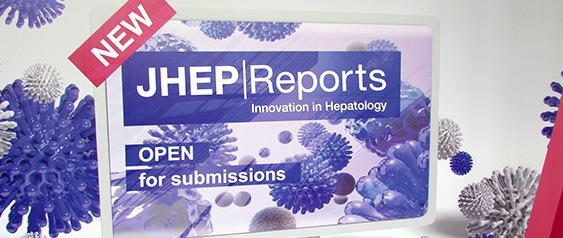
JHEP, continued success and new endeavours
Since its 30th anniversary in 2015, the Journal of Hepatology has published increasing numbers of high-quality original articles, achieving an impact factor of 15.04 in 2017. In the Best of JHEP: 2015–2019 symposium, Rajiv Jalan, the Editor in Chief, reflected on the journal’s achievements over the past 4 years:
- An average of 2,000 original manuscripts submitted and reviewed per year (2015–2019)
- A rise in overall quality, with an increased number of citations for most articles
- Increased quantity and quality of basic science papers published
- Improved layout, readability, transparency, reproducibility, and scientific integrity
- International impact: more and more papers originating from Asia and the USA
Dr Jalan and the Journal’s co-editors, Jessica Zucman-Rossi, Sophie Lotersztajn, Thomas Berg, Ramon Bataller, and Richard Moreau each presented their picks of the top papers and reviews in cirrhosis and liver failure, cancer, basic science, viral hepatitis, and ARLD/NAFLD.
Extending the excellence of JHEP, Professor Zucman-Rossi announced the launch of JHEP Reports. With the first issue already published, this innovative publication aims to become a gold-standard open access journal and one of the top 10 journals in the field of gastroenterology and hepatology.
Looking to the future, in 2019 JHEP will see a completely new group of editors. Paolo Angeli, the new Editor in Chief, introduced the new team and outlined their strategy for the future: to improve the quality of both submitted papers and those selected for publication, and to further increase the impact factor.

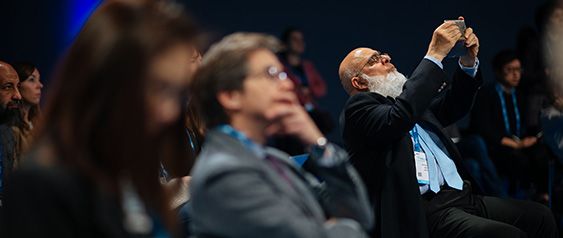
Prioritising HCC treatment – unpicking discrepancies between guidelines and real life
International guidelines present a range of recommendations for prognostic assessment in HCC. Shifting stage migration advice and the introduction of several new therapies adds complexity to the selection of patients for appropriate treatment of at each disease stage. Today’s liver tumors symposium, chaired by Professor Peter Galle, aimed to shed some light on the process.
Surgery is the mainstay of treatment for BCLC-A stage HCC. Vincenzo Mazzaferro discussed the key elements to consider when identifying appropriate surgical interventions, emphasising the importance of multiparametric evaluation including assessment of portal hypertension, extent of resection and liver function. He also summarized the use of composite criteria and prognostic calculators for selecting liver transplant candidates.
Riccardo Lencioni showed how progress in the treatment of intermediate HCC has been hampered by numerous negative clinical trials that have dashed hopes for many approaches. Radiofrequency ablation and TACE remain the standards of care for early-stage and intermediate-stage HCC, with thermosensitive drug carriers, adjuvant treatment regimens and combination of TACE and immunotherapy being explored in Phase 3 trials.
Maria Reig guided the audience through the available clinical data on new tyrosine kinase inhibitors and immunotherapies for advanced HCC and suggested how best to identify patients most likely to benefit most from specific first- or second-line treatments. She stressed the need to carefully evaluate the inclusion and exclusion criteria of clinical studies and to determine how these apply to each patient under consideration.

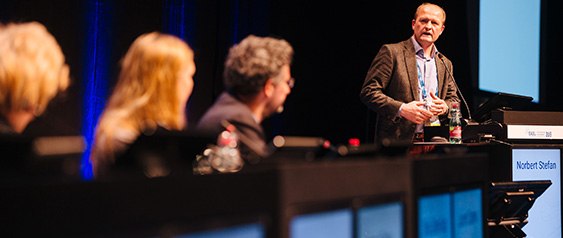
Proactive primary care in NASH
There is an urgent need for strategies to raise physician awareness across the healthcare spectrum and improve patient management to mitigate the impact of NAFLD/NASH and related comorbid conditions. Multidisciplinary approaches were discussed today at a symposium co-organized by EASD, ESPCG, and EASO.
NASH, the most severe, progressive form of NAFLD, is expected to be the number one indication for liver transplant by 2020 yet remains underdiagnosed and poorly managed. PCPs are often unaware of the risks in their patients and uninformed about the important interventions they can make. In today’s symposium, a team of experts focused on three key topics:
- Role and perspective of primary care in the management of NASH – including educating PCPs on risk factors, non-invasive tests, when to refer, and NAFLD screening in patients at high risk of cardiovascular disease
- Optimal management of diabetes in the setting of NASH – how to educate PCPs and diabetologists on the common metabolic causes and markers shared by NASH and type-2 diabetes mellitus
- Optimal management of obesity in the setting of NASH – educating HCPs on the concept of obesity as a disease which leads to NASH, and the huge opportunities to reduce disease burden through lifestyle interventions and pipeline therapies

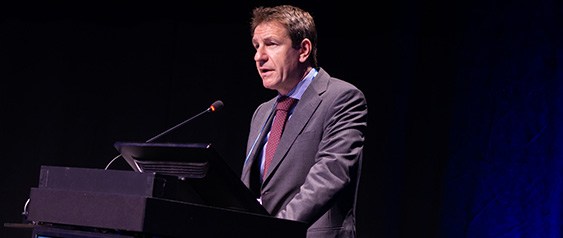
An interview with the new Secretary General
Hear about plans for the future from EASL’s new Secretary General, Philip Newsome

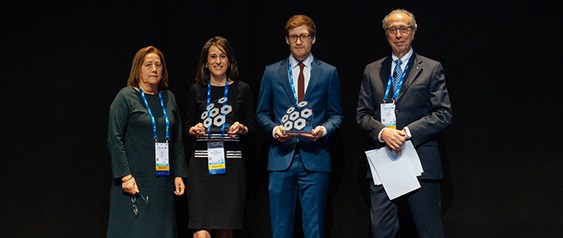
Stepping up to unmet clinical needs
In today’s General Session III, final results from the MYR203 Phase 2b trial revealed promising progress in the challenge of chronic hepatitis B/D virus (HBV/HDV) coinfection. In combination with PEG-interferon-α-2a, bulevirtide (Myrcludex B), a first-in-class entry inhibitor, resulted in high rates of off-treatment HDV RNA suppression with HBsAg loss achieved in some patients.
Other news from the General Session included:
- In the ENVISION Phase 3 study, givosiran, an investigational RNAi therapeutic targeting aminolevulinic acid synthase 1, significantly lowered the mean annualized rate of composite attacks in patients with acute hepatic porphyria
- Liver-derived stem cells (HepaStem) infused in patients with acute-on-chronic liver failure (ACLF) or acute decompensation showed some signs of efficacy in a European Phase 1/2a open-label study
- Winning the ILC 2019 award for best basic science oral abstract, Romina Salpini presented data showing that integration of HBV DNA into the human genome occurs in individuals with HBeAg-negative disease, even those with plasma levels of HBV DNA <2,000 IU/ml who do not meet current treatment criteria, suggesting that these patients may be at risk of disease progression and HCC

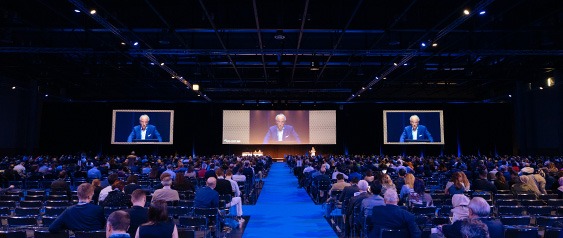
Keeping it real – challenges and successes in clinical practice
Presenters in today’s parallel sessions shared a wealth of real-world experience with the latest treatments for liver cancer and HCV, along with updates on promising clinical developments in rare liver diseases and some novel microbiome-based prognostic and treatment approaches.
Systemic therapies for advanced HCC in the real world
In the liver cancer session, studies from Japan and Europe provided much needed real-world data showing favourable therapeutic responses and safety profiles with first-, second- and third-line levanitanib, nivolumab, or pembrolizumab in broader patient populations than were included in clinical trials. A key future challenge raised in the discussion will be to define the best approach to measuring the efficacy of these new systemic treatments in a clinical setting. A retrospective review of data from participants in Phase 1/2 clinical trials of checkpoint inhibitors found that hepatic immune-related adverse events were common and associated with reduced disease progression, prompting the question of whether CTCAE criteria used in clinical studies should be revised to provide more clinically relevant information.
Promising new agents in rare liver diseases
Clinical trials presented in the rare liver disease session highlighted novel agents for conditions with limited treatment options. In Alagille syndrome, two Phase 2 studies into bile acid transporter inhibitors, A4250 and maralixibat, demonstrated reduced serum bile acids and improved pruritus with good tolerance. Maralixibat also reduced xanthoma severity and improved quality of life over 48 weeks. Week 120 data from the Phase 3 DIPAK-1 study provided robust evidence that the somatostatin analogue lanreotide associates with sustained reductions in liver growth in patients with polycystic liver disease associated with autosomal dominant polycystic kidney disease. In a heterogenous population with lysosomal acid lipase deficiency, a Phase 2, open-label study in sebelipase alfa also demonstrated safety and efficacy, with sustained improvements in liver and lipid parameters over 144 weeks.
Vive la difference – the benefits of microbiome diversity
The gut-liver axis, a pivotal component of many liver diseases, is closely linked to the composition of the gut microbiome. Researchers from the University of California at San Diego reported strong familial correlation of gut-microbiome composition and suggested a novel faecal-microbiome-derived signature with high diagnostic accuracy for NAFLD-cirrhosis. A study aiming to define specific changes in the microbiome during HBV-related ACLF, identified distinctive, less diverse, profiles of faecal microbiota and bile acids in patients with disease progression than in healthy controls. An award-wining presentation by Juned Ahmad from India, described how manipulation of the microbiome via faecal microbiota transplantation (FMT) in patients with HBV-ACLF increased transplant-free survival, and reduced hepatic encephalopathy and infectious complications when added to treatment with tenofovir. As a potential future alternative to FMT, a probiotic supernatant reduced body weight and liver fat, and improved liver function in a mouse model of fatty liver with obstructive sleep apnoea.
Highlights and hurdles in the fight against HCV
Global eradication of HCV requires that DAAs are effective in diverse populations in clinical practice. Encouraging real-world data demonstrated a high SVR12 rate (95.9%) with elbasvir/grazoprevir in 611 patients with HCV genotype (GT) 1 infection receiving opioid agonist therapy, 71% of whom were on concomitant psychiatric medication. Despite many success stories, challenges remain, such as reduced efficacy of DAAs in patients with virological failure and specific NS5A resistance-associated substitutions. Strikingly low SVR rates (75%) were observed among individuals with distinct HCV GT 1 non-1a/non-1b subtypes in a migrant population from West Africa – this subgroup represented 32% of the study population. Given the higher HCV genetic diversity in Africa and among African migrant populations in Europe, these data have important implications if we are to avoid a ‘potential epidemic of virological failures’. Further study is warranted to confirm novel genotypes and identify DAA regimens effective in treating them.

ILC Insights

Hear about the most exciting ILC 2019 late breakers

Global data in the parallel session on HCV treatment and resistance

What is EASL for you?

Highlights of the day

An exciting day at ILC 2019, catch the highlights here

Acknowledgements
‘ILC Daily News’ was supported by grants from: Bayer, Boehringer Ingelheim and Eisai
